Monsoon Festival from The Hills of The Northeast.
June 15, 2014What is that, which you cannot live without? Oxygen! And? And yes! Water! Water is life. Water has helped us grow as a species. Civilizations have flourished by the banks of great rivers; technology has progressed by leaps and bounds- all with the aid of water. No wonder water is venerated all over the world, no surprise that we celebrate the rains and worship the rivers. In other words we love the first soothing showers of monsoon, especially more so after the seemingly long spell of summer heat.
India celebrates the monsoons in many colorful ways, with rituals and traditions characteristic of a particular state. So we have Teej in Bihar, Rajasthan, and almost all of North India: Raja Sankranti in Orissa; Onam in Kerela which welcome the Monsoons grandly. The verdant freshness, the newly washed look and the cool breeze of the Monsoons bring a festive air to the whole of the country setting off numerous celebrations. Even religion has deep and significant correlation with this season as can be seen from Janmashtami, Raksha Bandhan, Naag Panchami , Ambubachi mela (Assam), Kang or Rathyatra (Manipur)to name a few which has it roots in mythology. Speaking of Religion, it will be unfair not to mention the Saffron procession of Kanwarias , the devotees of Lord Shiva , on foot from all over Indian in Sawan or July-August to Haridwar to fetch a kanwar or the baskets of Ganga jal (Water from the Ganges). And of course we have the biggest celebration of all, though unrelated to the monsoons, but one which is the most important for all of us Indians- The Independence day.
However our focus today is more on the ethnic and lesser known festivals from the Hills of North East. They maybe lesser known, but are celebrated with equal fervor and the festivities are as colorful as that of any other place. Their origins are steeped in folk lore, culture and tradition and each makes for an interesting piece, which, we will definitely bring before you one day complete with photographs and also onsite reporting, but how about a short trailer today of the monsoon festivals of North east-straight from amidst the common men? We bring before you today a brief description of the ethnic festivals held during the Monsoons from the Hills of The North East India.
Dree (Arunachal Pradesh)–
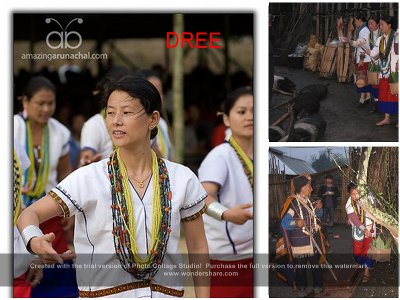 Location/ venue– Nenchanlya which is centrally located in the zero valley of the Lower Subansiri district of Arunachal Pradesh
Location/ venue– Nenchanlya which is centrally located in the zero valley of the Lower Subansiri district of Arunachal Pradesh
Time and dates– The festival is more a seasonal affair than a lunar one but for convenience’s sake, the dates have been fixed as from 4th of July to the 7th of July each year
Celebrated by – The Apatanis , an important tribe of Arunachal Pradesh. They are primarily dependent on agriculture and to their credit they have the distinction of practicing eco friendly methods of agriculture without the aid of any scientific machineries or farm animals- a really commendable feat, (noticed even by UNESCO)and those which have managed to successfully utilize their resources to the maximum productivity
Significance of the celebrations.- Dree which literally means ‘borrowing or purchasing of grains to meet one’s shortage’ is an agricultural rite or a prayer for a good harvest and prosperity. Like all religions of animistic origins, it involves the sacrificing of fowl, eggs to the Sun and Moon God or Tanu, Mitii and Danyo Piloo to appease them for a good harvest
Legend– There are many versions of folklore about the Dree festival but the most popular of them is the one where Abotani the ancestor of all mankind equivalent to the Bible’s Adam, once saw a bunch of paddy hanging from a tree and for which he undergoes a lot of hardships . Abotani and his wife Diiliyang Diibu cultivated those seeds and became prosperous after a good harvest. However call it divine justice or curse of a woman scorned, his fortunes began to dwindle after he divorced Dilyang Diibu and married Tini Rungya. Finally when famine struck, the Sun and Moon god took pity on him and advised him to perform the rituals (which came to be known as Dree) and appease God Tanu to destroy the pests and Yapang the rain God for protection of the crops. Those rituals were followed by his descendants and that is how Dree came to be celebrated among the Apatanis
History- Dree was officially celebrated for the first time in 1967 after formation of a central committee for its celebration. Dates were fixed after a mass consultation as from 4th of July to the 7 th of July and the venue was decided upon as Nenchalya in Ziro valley of Lower Subansiri district. Since then, every year the valley comes alive with the celebrations during the month of July.
Rituals– Four altars are made for the four deities that are worshipped during the festival -Tamu God, The Sky God , Metii God and Danyo Pilo –The Sun and Moon God. The priest or Dree kholi or Dree gora are appointed by the community to conduct the ceremony and are entrusted the responsibility of coordinating the arrangement, but since it is a community celebration, every family pitches in with resources like grains, fowl, eggs and of course the apong or rice beer (barring the ceremonial beer which has to be strictly prepared by the priest).
On the day of the prayers the priest attired as warriors gather in the Lapang or the community platform where they sacrifice fowls and recite incantations to invoke the blessings of the God! You may find it interesting to note that a cock is sacrificed to check for divine signs. If the heart of the cock is found to be healthy, then it augers a good harvest. There is also a ritual involving a sacrificial structure which is cut into pieces and thrown in the water after the completion of the lapang rituals marking the destruction of the pests and other harmful influence of the crops. Celebrations are marked with dancing and singing competitions and a collective prayer to protect the crops and shower a bumper harvest, so as to ensure the well being of the society. Rice beer flows freely and there is much merriment and joy. A noteworthy thing is the tradition that requires the women of the house to offer rice beer to son in law, brothers and sisters as a gesture of love and goodwill. Now isn’t that absolutely “cool” so as to speak in modern lingo?
Earlier a 7 day taboo period ( for agriculture)use to follow the merry making but now with modern times rituals have slightly changed to accommodate feasibility.
Tuluni-
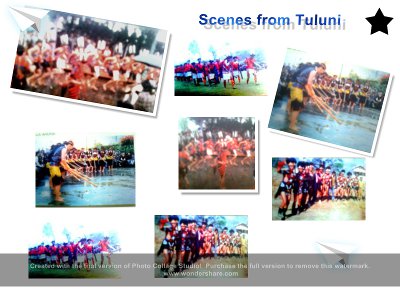
Tuluni , another monsoon affair comes straight from the mystic land or Nagaland.
Time– Though the date isn’t a fixed one, still it has been timed at the second week of July as it is the time when every thing is aplenty and a gala feast comes as a welcome change.
Venue– It is celebrated all over Nagaland and by all the tribes (now a days)
By Who :- The Sumi nagas or the Sema nagas are one of the powerful warrior tribes of Nagaland. Though they were of pantheistic or animistic belief prior to the coming of the Christian missionaries, but after their arrival majority of them converted to Christianity. Even after the conversion, some festivals still persisted as a connection to their ancient rituals like for example Tuluni, which is one such festival.
Significance– Tuluni named after the ritualistic rice beer served in a goblet of leaves is a symbolic ritual celebrating prosperity and peace. Since July symbolizes nature’s transformation from the dry winters to the rich green fruitfulness, this period is hence marked for the celebration of the coming prosperous season. It also serves as an occasion to offer prayers to the God of plenty Litsaba for prosperity and is a time for strengthening of both old and new relationships by some rituals one of which is between a newly betrothed couple and their families. The whole of the community rejoices with feasting and plenty of merry making during Tuluni.
History– The Sema tribe, consisting of two clans – The Swu and Tuku, were the warriors of yore but agriculture still played a pivotal role in their lives. The festivals like in most of the hill tribes usually had a connection to farming. Either it marked the change of seasons or it would be an occasion to offer prayers for a bountiful crop or some times as an aberrant to mark a victory in war. Tuluni is celebrated after the seeds are sown as a celebration of the shift in the season, which is commonly believed to ensure a good harvest. Though in the earlier times, it was celebrated in Zunehboto district by the Semas, now each and every tribe comes out to celebrate the festival in harmony all over Nagaland.
Rituals and customs:- The rituals and customs differ slightly among the two different clans though the purpose and the intent are the same. It has the same community participation as in Dree. The members of a farming group are entrusted with the arrangement and the resources for the fest are pooled. Ritualistic rice beer is prepared and served in goblets of plantain leaves and drinking of the same marks the essence of Tuluni. There is of course the customary sacrificing of fowl and cows to appease the Deity and the community feasts, dancing and singing. Exchange of gifts takes place among the betrothed and their families. There is abundance of love and joy among the people signifying a new beginning like the fresh green leaves on the trees.
Mim Kut– –
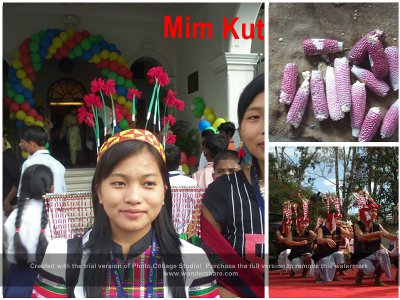 From the wild beauty of Nagaland let us move on to the lovely pristine landscape of Mizoram for a unique celebration Mim kut or the maize festival , which is held after the harvest of the maize crops (as the name suggests)for offering the respects to one’s dead relatives .
From the wild beauty of Nagaland let us move on to the lovely pristine landscape of Mizoram for a unique celebration Mim kut or the maize festival , which is held after the harvest of the maize crops (as the name suggests)for offering the respects to one’s dead relatives .
Time. – It is an annual festival held after the maize crop harvest. Though it is a seasonal celebration the dates are dependent on the harvest, but usually the three day celebrations are held during the months of August- September.
Venue– It is held throughout Mizoram and not restricted to any particular region. Though Christianity is the primary religion of Mizoram, the Kuts or festivals that are still celebrated are an indication of the people’s connection to their indigenous past or their roots as a Kuki-Chino-Mizo tribe which is said to have been the descendents of the twelfth missing sect of Israelites.
Significance– Though it is known as the maize festival after its tradition of celebrating the harvest, it is also known as the Feast of the Weeping (as it invokes the sprits of the relatives who had passed away).
Legend– If we go by ancient history, Kuts of Mizoram have a great significance as it is celebrated in Manipur, Myanmar and as far as Singapore affirming its Chino-Mizo-Kuki- Jewish connection. By that theory the tradition can be traced back to as far as 3000 years old. Another explanation of the Kuts are its basis in nature worship, which the Mizos practiced prior to embracing Christianity and which may explain the worshipping after a harvest as thanksgiving.
Another legend has that once there was a loving couple, but the wife died leaving the husband in great grief. One day miraculously he came upon his dead wife in a strange land called Mithiko, where he found her in great hunger and she asked him to bring some food from their fields as there was none to find . He immediately carried out her wishes and also shared his experience with other members of the tribe. This tradition came to be followed throughout down the ages as Mim kut.
Celebrations and rituals– Whatever may be the origin; the festival is celebrated with all gaiety and sincerity. The first day is spent in those rituals invoking the dead and offering of tributes. A platform is built as a memorial where the people gather to offer their tributes to the dead. The merriment is reserved for the second and third day with delicacies of bread being the prime item in the feast. Like all tribal traditions Zu a locally brewed rice beer is consumed (illegally of course) as a part of the age old tradition. Dancing, singing and competitions mark the celebrations.
Additional remarks– However there is concern in certain sections of the society about the modifications and modernization of the celebration as it may lose the meaning and significance of the rituals in future due to these modifications.
Kharchi Puja–
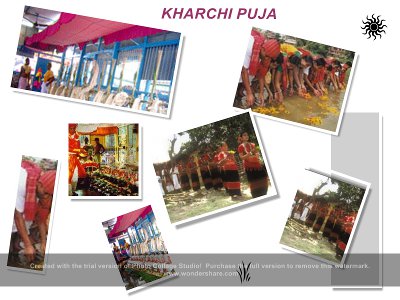
From Arunachal Pradesh, Mizoram and Nagaland, let’s take you to Tripura for a unique celebration- The Kharchi Puja- which again initially was a tribal ritual. The ritual is a prayer to the mother Earth for the sustenance of human kind and is also known as Chaturdash or Chauddha Devta puja as fourteen deities are worshipped in the form of fourteen heads. It has an interesting history born out of folk lore and to some an extent from the History of the Kingdom of Tripura.
Time–
It follows the lunar calendar unlike the tribal festivals mentioned in this article . It is celebrated in the month of Ashad and falls on a Suklasthami or the eight day after the new moon which roughly comes to around June-July and celebrated for seven days.
Venue–
Kharchi puja which has a royal association is held every year in the Chauda Devatash Bari , a temple in Old Agartala, which was the capital city of the then rulers of Tripura.
Who– Celebrated by the Tripuri and non Tripuris alike, you will find it interesting to know that this festival has tribal origins which later on came to be incorporated according to the Hindu system.
Significance–
It started basically as a cleansing ceremony performed 15 days after Ambubachi ,( the period when the mother earth is supposed to menstruate.) Accordingly on the fifteenth day the Mother earth is first purified and then worshipped for welfare and sustenance of the people along with the fourteen deities –Hara, Uma . Hari, Ma, Vani. Kumara,Ganapa, Vidhi , Kha,Abdi, Ganga, Sikhi,kama and Himadri, who are the clan deities of the Tripuri people
The festival said to be traced back to around 3000 years ago, has an equally interesting history as the legend that surrounds it, though its authenticity could not be verified.
Legend
Legend has it that King Tripur ruled the land, after whom it is called Tripura. The king was a cruel king and to free themselves of his oppressive rule the people worshipped and called upon lord Shiva to deliver them. The Lord was pleased by their prayers and killed the king. He also blessed the queen to have a son who would rule the kingdom justly and directed the people to worship the fourteen Gods for welfare and prosperity and henceforth the people started worshipping the fourteen Gods
History- History has afar bloodier version of the origin of the puja. According to the ancient history as stated in Rajmala- the chronicles of the rulers of the Tripura, Drikpati the eldest son of King Trilochan the erstwhile king of Tripura was named the heir to the kingdom of Cacchar by his maternal grandfather. Trilochan meanwhile ceremonially declared his second son Dakshin as the prince and upon his death Dakshin became the king. But as Drikpati was the eldest son, he asked for his inheritance as the rightful heir to the throne. This then resulted in a war between the two brothers where Dakshin was defeated forcing him to give up the throne and set base instead towards the south and establish a new capital. It is said that he had taken the heads of fourteen soldiers with him while fleeing and since then the descendents have been worshipping the fourteen heads.
The rituals, ceremonies and tradition– The festivities last for seven days and it’s a strict decree that only the Chantais or descendents of the royal priests will be allowed to perform the puja. None other than a Tripuri can perform the puja. On the first day of the puja, the deities are taken by the Chantais to the river Saidra and the idols bathed. They are then again taken back to the temple and decorated with flowers and vermillion. Sweets, goats, buffalo are offered to the Gods . Fair and cultural programs are held as part of the festivities. It should be noted that the deities (except three of them) are open to the public for worshipping only on the day of the puja, while rest of the days of the year it is packed away from the public eye. Previously it used to be a community celebration, but now every one joins in the puja. Religion and spirituality knows no boundary just like water. God is for everyone.
Beidenkhlam-
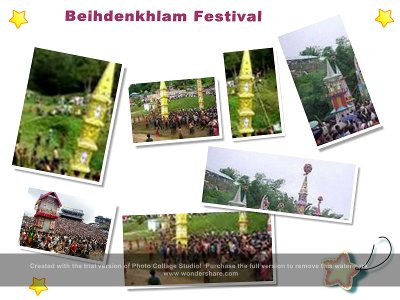 You have heard of celebrations for birth, marriage, harvest , rituals for the dead , for protection, but have you heard of a ritual seeking protection against a disease and that too, specifically one particular disease. Beidenkhlam is a ritual which signifies chasing away the demons of the disease of cholera performed down the ages.
You have heard of celebrations for birth, marriage, harvest , rituals for the dead , for protection, but have you heard of a ritual seeking protection against a disease and that too, specifically one particular disease. Beidenkhlam is a ritual which signifies chasing away the demons of the disease of cholera performed down the ages.
When– Like most of the festivals during this season, It is related to agriculture and is held after the sowing is over
Venue– It’s celebrated in a big way in Jowai, an important town in the Jaintia hill is of Meghalaya and it is the most important dance festivals of the Jaintias
By Who– It is the festivals of the Jaintias, more specifically the Pnars- a tribe of Meghalaya
Significance– The significance of this long duration festival is to ward of all evils including diseases and other evils that plague our planet. Cholera is just a symbolism. Like all prayers it is an invocation for blessings of happy, healthy and prosperous times.
Legend and history– It is said that the ritual originated when the seven huts descended from the heaven to start a new life. They had predicted and warned the people of a great plague wiping out the whole of their population. Alarmed, they prayed to their Gods Mulong, U Mukhai and Musniang who advised them to worship every year their deities for protection and to perform the rituals to ward of the demon of the disease.
The rituals and celebrations are an elaborate ones. The preparations start around a month back with the first sacrifice called Knia Khang followed by the minor rituals. Vigorous preparations start a week earlier to the main festival when they fell huge trees to make those huge poles to chase away the demons and also the main beam like Khong blai for the ceremonies
On the first day the Khong blai is brought in which is set in Aitnaar a sacred pool of the ritual.
On the second day of the last part of the festival, after a sacrifice, seven male members from the seven chosen localities go to fetch those poles or Dein khlams which are not brought in directly , instead halted overnight midway.
On the third day the trees are planted in the centre of the locality while on the last day the young men make a symbolic gesture of driving away the demons by beating the roofs of the house with those trees. all the while rituals and prayers are performed by the Langdohs or priests of the ceremony.
On the last day after the whipping is over all the young and old converge in the sacred pool for a game of good natured wrestling style pushing game for a foothold in the Khong blai immersed therein. Later in the afternoon the festival culminates with a game similar to football called dad la wak. There is much merry making, feasting, dancing and drinking but women stay away from the dances as they are part of the ceremonial group that offers tribute to the forefathers.
After word– Wine and dancing used to be a common link between the festivals of the hills. Simple in their living and demands, their merrymaking were one of the most zealous.
Not that they led a very easy life. Life is a struggle in the hills. It is bereft of luxuries and rather a journey steeped in hardships. But they went on, each important moment of life captured and marked in rituals, prayers and merry making. Maybe that was their way of embracing life full on and living it to the fullest, with no complains and minimum of expectations. Maybe that was their way of saying- You cannot defeat our spirit. Come what may, we will live!
Sources-
- Lovely Arunachal
- Akono Sakhrii, Ficto Pachau
- Wikipedia
- http://jaintia.nic.in/Festivals.htm
- http://www.scribd.com/doc/41807618/Origin-of-Kut-and-Its-Cultural-Heritage-from-www-thalmual-com
- http://www.north-east-india.com/nagaland/tuluni-festival.html
- http://en.wikipedia.org/wiki/Sumi_Naga
- http://www.north-east-india.com/meghalaya/behdienkhlam-festival.html
Photo Credits-
- Lovely Arunachal
- A. Sakhrii
- Rajkumar 1220
- www.everystockphoto.com
We welcome your comments at letters@friedeye.com




That was quite an interesting bit of information. However we would like to clarify that through the article we were not trying to generalise it , rather we were just presenting one of the beliefs. 🙂 But Well I on my part will surely follow it up. Thanks
Thanks for the warm welcome….
Well….I would like to inform you that those who believe that they are the descendants of the Israelites are a very ,very small section in the society who follow Judaism…. It is misinformation to generalise and mention that the mizos believe it so .History tells us us that the Mizos belong to the mongoloid stock and originated from a part of China .
Thanks Himpuii for your appreciation. I am sure if you believe that you are not descendants of the Israelites then you have a good reason to do so. We are always open for criticisms, admiration and also information. We would love to listen to your views and if necessary bring them to the world outside. once again a warm welcome to you to Fried Eye 🙂
Like the contents and like even more the heading…North East is beautiful all around during the monsoons and to mention the festivals during this time makes it so much more interesting …..
Would also like to mention I am one of the many, in fact the vast majority of the Mizos who do not believe that we are the descendants of the one of the lost tribes of the Israelites.:)
Thanks Neal. We are too. Keep on visiting and bring your friends too 🙂
i liked it and is proud of it that am in North East…
we are happy that you liked it . The length could not be helped. We tried to make it brief but… 🙂 almost every information seemed important
I really liked this, though it is a tad long.